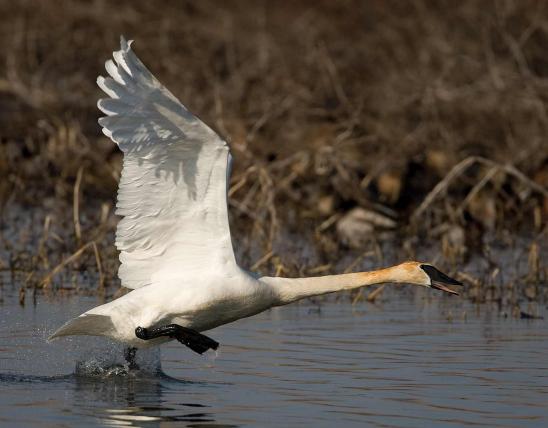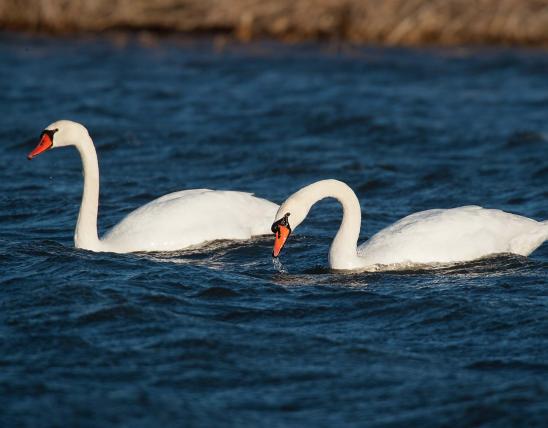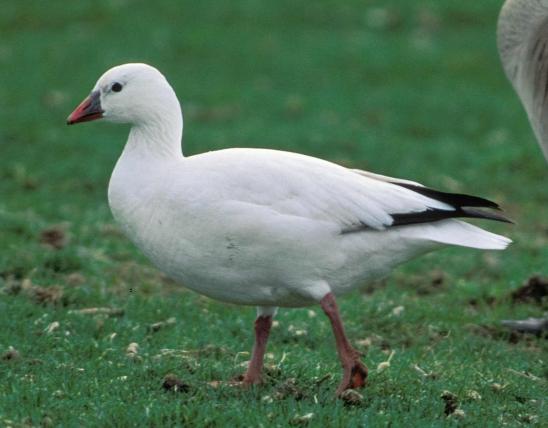The tundra swan is a long-necked, all-white bird that can be distinguished from the trumpeter swan by its slightly concave bill profile, with the rear point of the bill tapering to and just touching the black eye. Often there is a small yellow spot in front of the eye. It is a rare migrant and winter resident in Missouri. Look for them on large bodies of water, wetlands, and agricultural fields.
The voice is a musical “klooo ” or “kdrooo.” It is higher pitched than the voice of trumpeter swans.
Similar species: Missouri’s other two swans are the trumpeter swan and the mute swan; they are both larger than the tundra swan:
- The trumpeter swan is distinguished from the tundra swan by its straight upper bill and the broad base of the bill against the eye, making the eye appear as part of the bill from a distance.
- The mute swan is not native to our continent but can escape from parks; it has become established in many parts of the United States. It has an arched neck, orange bill, and black forehead knob.
Large white birds flying overhead are sometimes difficult to identify. Often white plumage appears black when the sky behind the bird is light. People often confuse swans and geese; swans are larger and have proportionately much longer necks.
Length: 52 inches (tip of bill to tip of tail). Smaller than trumpeter and mute swans.
Statewide, in appropriate habitats.
Habitat and Conservation
Rare migrant and winter resident at marshes, lakes, and rivers; also seen foraging in agricultural fields.
The tundra swan has a Holarctic distribution: it occurs all around the Arctic Circle, in both the Eastern and Western hemispheres. Our American subspecies is called the whistling swan (Cygnus columbianus columbianus), while the one in much of Eurasia is called the Bewick’s swan (Cygnus columbianus bewickii). The latter is slightly smaller and has a very much larger yellow patch at the base of the bill.
Food
Tundra swans feed on aquatic vegetation, such as sedges and pondweeds; they graze on emergent parts of the plants as well as submerged parts, including rootstocks. They also visit wintertime crop fields for grains and beans. They also eat insects.
Status
Rare winter resident.
Life Cycle
Present in Missouri from late October to late March. They fly north in spring to their Arctic breeding territories in far northern Canada and Alaska. Breeding habitat is in river deltas and wetlands during the short northern summer. The male and female both build the nest of grasses, sedges, and other available vegetation on raised areas near water. The nest is a mound of vegetation with a cup-shaped hole in the middle. A clutch comprises 3–5 eggs, which are incubated for about 31 or 32 days.
The young are able to walk within hours of hatching and can fly 65 days later. They stay with their parents during their first winter. Once tundra swans form a pair bond, the couple stays together for life. A tundra swan can live to be at least 23 years old in the wild.
Human Connections
The North American subspecies of tundra swan got the name of “whistling swan” when explorer Meriwether Lewis described the bird and what sounded to him like whistling calls. On March 9, 1806, he wrote: “its note . . . cannot be justly imitated by the sound of letters, nor do I know any sounds with which a comparison would be pertinent. It begins with a kind of whistling sound and terminates in a round full note. . . . From the peculiar whistling of the note of this bird I have called it the whistling swan.” To our ears, however, the calls don’t sound much like whistling.
The species name, columbianus, is in reference to the Columbia River in the Pacific Northwest, where Lewis and Clark first saw these birds “below the great narrows [The Dalles] of the Columbia near the Chilluckkittequaw [Wasco-Wishram] nation. They are very abundant in this neighborhood and have remained with us all winter.”
The celebrated documentary film Winged Migration has an enchanting segment showing several Bewick’s swans (the Eurasian race of tunda swan) in flight. The filmmakers used in-flight cameras, on ultralights, paragliders, and other flying equipment, to provide a bird’s-eye view of the flying birds. It’s as if you’re flying right beside them.
The genus name, Cygnus, is from the Latinized form of the Greek word for “swan.” One of the most easy to identify constellations is Cygnus, the swan. The constellation’s brightest star is the one in the swan’s “tail”: Deneb, which translates to “tail.” Cygnus is also called the Northern Cross, because it is proportioned similar to a typical Latin Christian cross. It is visible overhead in the evenings all summer long. Its bright star Deneb, plus Altair and Vega (the brightest stars of two nearby constellations), form the famous Summer Triangle.
Ecosystem Connections
Climate change may cause these magnificent birds to lose from nearly 50 percent to more than 90 percent of their summertime breeding territory. As the climate in North America warms, there is simply little land farther north for them to shift to.
Many predators seek the eggs and young of tundra swans, and the parents guard their nests avidly. But it only takes a moment for a gull, jaeger, raven, fox, or eagle to snatch an egg or nestling. They also defend their nests from other swans. Although they travel during migration in flocks, they nest separately from each other and defend separate territories.
About 350 species of birds are likely to be seen in Missouri, though nearly 400 have been recorded within our borders. Most people know a bird when they see one — it has feathers, wings, and a bill. Birds are warm-blooded, and most species can fly. Many migrate hundreds or thousands of miles. Birds lay hard-shelled eggs (often in a nest), and the parents care for the young. Many communicate with songs and calls.


























